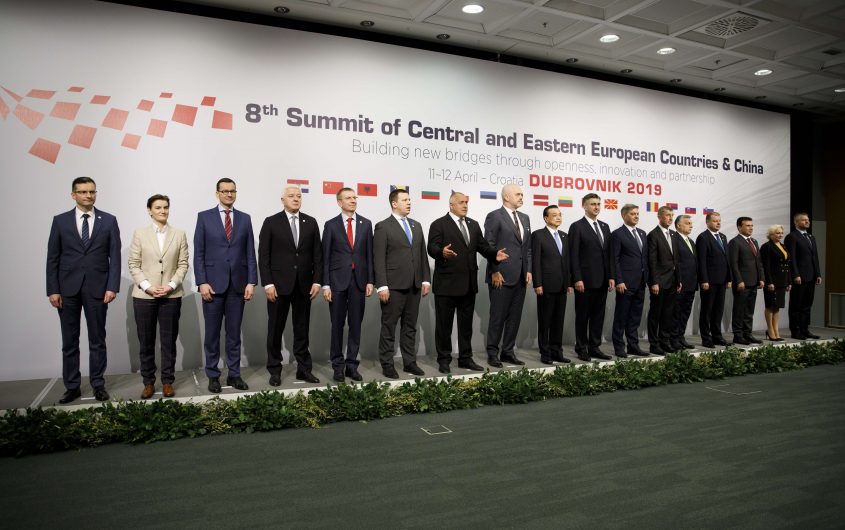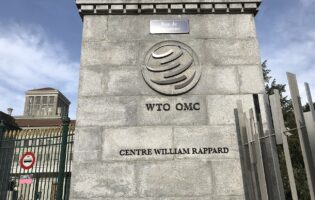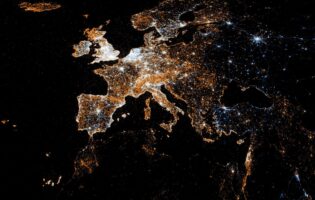
JP Black/LightRocket via Getty Images
From 16+1 to 17+1: The EU’s Challenge from the Rebranded China-CEEC Initiative

Yixiang Xu
China Fellow; Program Officer, Geoeconomics
Yixiang Xu is the China Fellow and Program Officer, Geoeconomics at AGI, leading the Institute’s work on U.S. and German relations with China. He has written extensively on Sino-EU and Sino-German relations, transatlantic cooperation on China policy, Sino-U.S. great power competition, China's Belt-and-Road Initiative and its implications for Germany and the U.S., Chinese engagement in Central and Eastern Europe, foreign investment screening, EU and U.S. strategies for global infrastructure investment, 5G supply chain and infrastructure security, and the future of Artificial Intelligence. His written contributions have been published by institutes including The Chinese Academy of Social Sciences, The United States Institute of Peace, and The Asia Society's Center for U.S.-China Relations. He has spoken on China's role in transatlantic relations at various seminars and international conferences in China, Germany, and the U.S.
Mr. Xu received his MA in International Political Economy from The Josef Korbel School of International Studies at The University of Denver and his BA in Linguistics and Classics from The University of Pittsburgh. He is an alumnus of the Bucerius Summer School on Global Governance, the Global Bridges European-American Young Leaders Conference, and the Brussels Forum's Young Professionals Summit. Mr. Xu also studied in China, Germany, Israel, Italy, and the UK and speaks Mandarin Chinese, German, and Russian.
__
When Croatian prime minister Andrej Plenkovic welcomed Greece as the 17th European member of the Cooperation of Central and Eastern European countries and China at the fifth China-CEEC summit in Dubrovnik, many in Europe again worried that China’s growing influence in the CEE region is chipping away at EU cohesion. But aside from Alexis Tsipras’ enthusiastic arrival at the summit, the gathering didn’t arouse much attention. The Dubrovnik guidelines repeat much of Beijing’s existing vision for China-CEE cooperation while adopting a more conciliatory tone toward the EU.
The China-CEEC Initiative, colloquially known as 16+1 before Greece’s accession, was launched in 2012 to expand and intensify China’s cooperation with eleven EU member states and five western Balkan countries focusing on transportation infrastructure, trade, and investment. One year after its inception, Beijing revealed its One-Belt-One-Road strategy, making the CEE region an important station on its new silk road terminating in western Europe.
Fanfare Meets Reality
Seven years on, the initiative has delivered rather underwhelming results for most CEE partners. Rather than building infrastructure to suit local needs, Beijing only supports projects it deems strategic, including steel mills, chemical plants, highways, and railways. While multiple projects are underway in Serbia and Montenegro, Chinese infrastructure projects have hit a wall inside the EU. EU public procurement rules and government transparency practices in member states have significantly slowed down progress in Chinese-led projects. Announced in 2014, the Hungarian side of the Belgrade-Budapest highspeed railway has yet to see any construction. The EU also accused China of debt trap diplomacy over the Chinese-financed Bar-Boljare highway in Montenegro, drastically increasing the small Balkan nation’s debt to 80 percent of its GDP.
EU public procurement rules and government transparency practices in member states have significantly slowed down progress in Chinese-led projects.
The amount of Chinese investment in the region is still relatively small. Approximately 10 percent of China’s European investments are in the CEE countries and the region itself receives around 90 percent of its investments from the EU and the U.S. At the same time, investments from Chinese private companies are still lacking, as are greenfield projects.
Aside from investment, Beijing has repeatedly pledged to increase trade with the region at previous summits. When trade with China grew, so did the trade deficit for CEE countries. In 2017, China’s exports to the region reached $49.4 billion, while imports stood at $18.49 billion. For countries like Poland, the increase in Chinese imports far outpaces exports to China. In the Czech Republic and Poland, for example, the growing trade deficit with China coupled with their failure to penetrate the Chinese market has raised concern there that the BRI partnership may only benefit China.
It has also been very clear from the beginning that the regional partners come from diverse economic and political backgrounds and have different development needs. Their shared communist history is often the only common thread of reference. Yet the 16+1 forum assembled a seemingly homogeneous bloc without creating a common denominator that unites all parties. Simultaneous promotion of bilateral channels by the Chinese government encourages CEE governments to compete for Beijing’s attention.
The 16+1 forum assembled a seemingly homogeneous bloc without creating a common denominator that unites all parties.
The only consistent part of the initiative has been China’s interests in developing the CEE region into its logistic hub for transporting Chinese goods from the Greek port of Piraeus to more lucrative markets in western Europe and the CEE countries themselves. The addition of Greece to the group is a natural extension of this strategy.
The EU’s Same Old East-West Divide?
Many in Brussels, Berlin, and Paris see the 16+1 as Beijing’s attempt to divide and conquer the EU by purchasing political influence in the CEE countries at the expense of internal EU cohesion. Greece’s refusal to condemn China’s human rights record and Hungary’s bucking of EU criticism of the BRI were promptly labeled as victories for Beijing’s influence campaign in Europe.
But when Angela Merkel urged Europe to speak with one voice to China, did she really mean the Franco-German voice? CEE leaders have long resented western Europe’s dominance in defining the EU’s relationship with China. The advanced economies in western Europe are more dependent on trade with China and yet when Merkel and Macron interact with Beijing, they are credited for acting in the best interests of their countries and the EU. In contrast, CEE leaders are increasingly accused of diluting EU unity and acting as proxies for Chinese interests when they court Chinese investment.
The advanced economies in western Europe are more dependent on trade with China and yet when Merkel and Macron interact with Beijing, they are credited for acting in the best interests of their countries and the EU.
Some CEE countries are also frustrated that EU policy proposals sometimes overlook the capacity and needs of their economies without providing enough alternative options. The EU’s drive to phase out coal subsidies by 2025 is a case in point. While the negotiations reached a last-minute compromise with a “grandfathering clause” for Poland that protects contracts awarded to energy generators under the country’s capacity scheme, western and northern EU member states firmly rejected a proposal that would exempt poorer member states based on their lower average GDP. But CEE countries will have a much harder time to comply with EU emission goals while meeting their domestic power demands without substantial support from the EU to develop alternative energy sources. The EU’s attempt to extend its energy market rules to its southeastern neighbors like Albania, Bosnia and Herzegovina, Montenegro, and Serbia was also promptly ignored by their governments. Bosnia’s Bosniak-Croat Federation has turned to China for a €600 million loan to build its Tuzla 7 coal power plant, drawing ire from the EU.
While regional leaders like Viktor Orban and Milos Zeman are staunch advocates for engagement with China, CEE member states’ publics do not back their governments’ pro-China policies. Only 40 percent of Hungarians and 25 percent of Czechs have a positive perception of China. An important factor that drives unabashed China apologists like Hungary to repeatedly flout the EU despite mediocre delivery from China is political opportunism within the EU. Brussels is right to point out that the country receives far more infrastructure development funds from the EU and that Chinese investments constitute a small fraction of overall FDI in Hungary and the region as a whole. But the bilateral relationship with China provides a rare leverage with the EU over divergent policy preferences on issues such as migration and energy.
One Voice Means One Inclusive Voice
The attitude shift in Europe on the economic relationship with China in the era of stronger scrutiny toward Chinese investments in Europe and the looming China-U.S. trade war is now driving the EU to push back on some core elements of China’s trade and industrial policies. While leaders in western Europe and Brussels want member states to have one voice toward China, the EU needs to build consensus on common interests in dealing with China and actively support the regional economic development of CEE countries.
Putting closer focus on leveling the playing field for trade relations with China would be a good place to start. Many CEE countries are increasingly frustrated by the lack of market access in China, which is likely a factor in their growing trade deficit with China. Growing amounts of cheap Chinese imports are also increasing pressure on regional manufacturers. While the CEE countries often don’t possess advanced technologies and thus are not primary targets for China’s strategic technology investments, their producers in industries such as textile and household appliances could be at risk of displacement and reduce the region’s competitiveness in these sectors. Therefore, pushing Beijing for more reciprocity for China-bound trade and investment could gather wide support from the CEE region.
Continuing and expanding support for regional infrastructure development helps to demonstrate the EU’s commitment to enhancing connectivity in CEE countries and dissuade them from seeking Chinese funding. It is good news that the European Commission recently adopted a €4 billion investment package for infrastructure projects across ten member states, including Bulgaria, the Czech Republic, Hungary, Poland, and Romania. These investments help to uphold EU infrastructure development standards and promote the bloc’s common social and environmental agenda.
The EU should also play an active role in the CEE region’s original cooperation platforms, such as the Three Seas Initiative (TSI). Unlike 16+1, the TSI has chosen a narrow and concrete focus on implementation of cooperative infrastructure, energy, and digitalization projects. These efforts could boost the capacity and competitiveness of CEE economies and that of the EU as a whole, making CEE countries stronger stakeholders and beneficiaries of the EU’s new trade and investment approach toward China.








